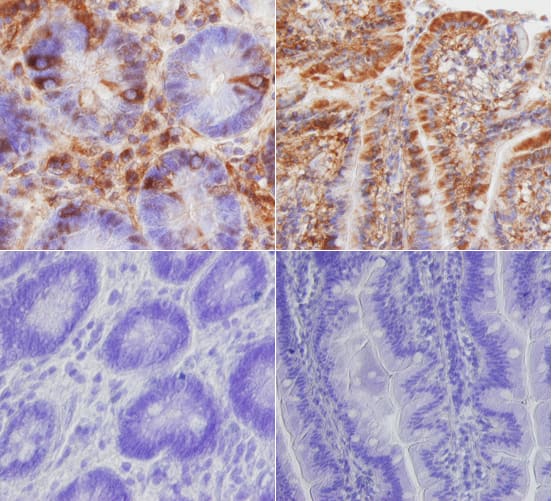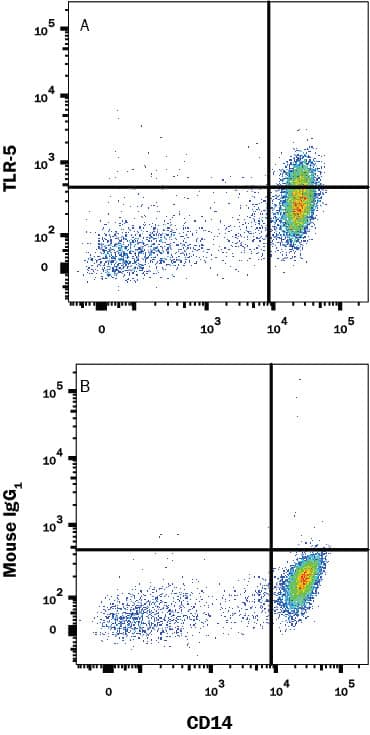Human TLR5 Antibody Summary
Ile21-Phe115
Accession # O60602
Applications
Please Note: Optimal dilutions should be determined by each laboratory for each application. General Protocols are available in the Technical Information section on our website.
Scientific Data
 View Larger
View Larger
TLR5 in Human Intestine. TLR5 was detected in immersion fixed paraffin-embedded sections of human intestine using Mouse Anti-Human TLR5 Monoclonal Antibody (Catalog # MAB6704) at 15 µg/mL overnight at 4 °C. Tissue was stained using the Anti-Mouse HRP-DAB Cell & Tissue Staining Kit (brown; Catalog # CTS002) and counterstained with hematoxylin (blue). Lower panels show a lack of labeling when primary antibodies are omitted and tissue is stained only with secondary antibody followed by incubation with detection reagents. Specific staining was localized to cell surfaces and cytoplasm. View our protocol for Chromogenic IHC Staining of Paraffin-embedded Tissue Sections.
 View Larger
View Larger
Detection of TLR5 in Human Human Peripheral Blood Monocytes by Flow Cytometry. Human Human Peripheral Blood Monocytes were stained with (A) Mouse Anti-Human TLR5 Monoclonal Antibody (Catalog # MAB6704) or (B) isotype control antibody (Catalog # MAB002), followed by Allophycocyanin-conjugated Anti-Mouse IgG Secondary Antibody (Catalog # F0101B) and Mouse anti-Human CD14 PE-conjugated Monoclonal Antibody (Catalog # FAB3832P). View our protocol for Staining Membrane-associated Proteins.
Reconstitution Calculator
Preparation and Storage
- 12 months from date of receipt, -20 to -70 °C as supplied.
- 1 month, 2 to 8 °C under sterile conditions after reconstitution.
- 6 months, -20 to -70 °C under sterile conditions after reconstitution.
Background: TLR5
TLR5 is an ~100 kDa type I transmembrane glycoprotein of the Toll-like receptor family. It is expressed on mucosal epithelia in the gastrointestinal tract, airways, and other areas of potential bacterial contact and recognizes bacterial flagellin. Expression is also reported on monocytes, immature dendritic cells, and CD4+ T lymphocytes. The region of human TLR5 used as an immunogen includes the first 2 of 16 leucine-rich repeats and shares 72% amino acid identity with mouse and rat TLR5. This region is outside of the flagellin binding region. Flagellin engagement induces dimerization and intracellular signaling via MyD88.
Product Datasheets
Citations for Human TLR5 Antibody
R&D Systems personnel manually curate a database that contains references using R&D Systems products. The data collected includes not only links to publications in PubMed, but also provides information about sample types, species, and experimental conditions.
3
Citations: Showing 1 - 3
Filter your results:
Filter by:
-
CHK1 and RAD51 activation after DNA damage is regulated via urokinase receptor/TLR4 signaling
Authors: Pavan B Narayanaswamy, Sergey Tkachuk, Hermann Haller, Inna Dumler, Yulia Kiyan
Cell Death & Disease
-
Thymoquinone-Mediated Modulation of Toll-like Receptors and Pluripotency Factors in Gingival Mesenchymal Stem/Progenitor Cells
Authors: M Mekhemar, J Tölle, Y Hassan, C Dörfer, KF El-Sayed
Cells, 2022-04-25;11(9):.
Species: Human
Sample Types: Whole Cells
Applications: Flow Cytometry -
Effects of Supplemental Calcium and Vitamin D on Expression of Toll-Like Receptors and Phospho-IKK alpha / beta in the Normal Rectal Mucosa of Colorectal Adenoma Patients
Authors: Rebecca Hodge, Hannah B. Mandle, Stephen Ray, Sonia Tandon, Meaghan Peterson, Abigail Henry et al.
Cancer Prevention Research
FAQs
No product specific FAQs exist for this product, however you may
View all Antibody FAQsReviews for Human TLR5 Antibody
There are currently no reviews for this product. Be the first to review Human TLR5 Antibody and earn rewards!
Have you used Human TLR5 Antibody?
Submit a review and receive an Amazon gift card.
$25/€18/£15/$25CAN/¥75 Yuan/¥2500 Yen for a review with an image
$10/€7/£6/$10 CAD/¥70 Yuan/¥1110 Yen for a review without an image






